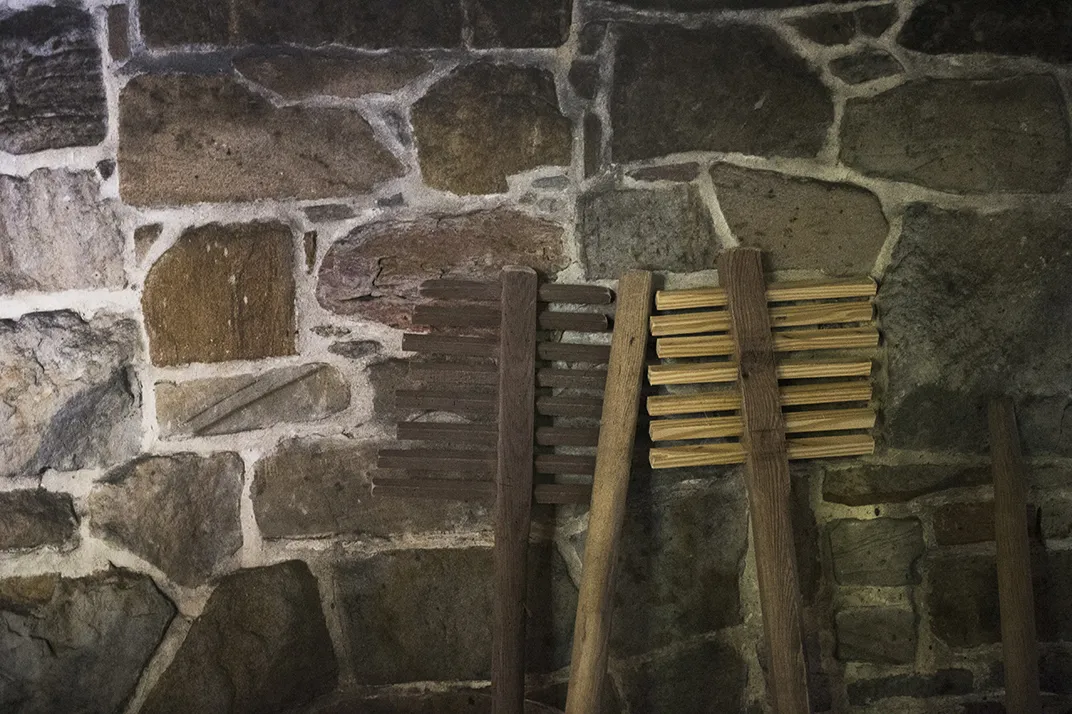Long Before Jack Daniels, George Washington Was a Whiskey Tycoon
The Founding Father spent his post-presidency years presiding over a booming alcohol business
When George Washington left the presidency in 1797, he was looking forward to some relaxation—returning to Mount Vernon and the pastoral life that had been distant during his time as president. But Washington was a man of innovation, who rarely let an opportunity slip by—and when he hired a Scottish plantation manager in 1797, Washington added another line to his resume: whiskey seller. The planation manager, James Anderson, had immigrated to Virginia in the early 1790s—noticed a missed opportunity at the estate: the abundance of crops, combined with Washington's state-of-the-art gristmill and abundant water supply could be used to make whiskey. And it wasn't just the abundance of crops, but the type. Washington, to help foster healthy soil, planted a lot of rye as a cover crop. Rye wasn't high on the list of delicious, edible grains, but Anderson didn't think it should go to waste—instead, he wanted to turn it into whiskey.
Washington was, at first, hesitant to jump into a new business venture—after all, at 65 years old, he had wanted to spend his retired years in relative peace, but after hearing Anderson's proposal, as well as corresponding with a friend who was involved in the rum business, Washington acquiesced. That winter, Anderson began distilling in the estate's cooperage, using just two stills (pots used for distillation). The first distilling was so successful that Washington approved plans for construction of a full-fledged distillery, complete with five stills. The distillery finished construction in 1798, and by 1799, it was the largest whiskey distillery in the country. That year, the distillery produced 11,000 gallons of clear, un-aged whiskey, which Washington sold for a total of $1,800 ($120,000 by today's standards).
So why isn't "whiskey businessman" a moniker more readily associated with Washington? Partly because, for nearly two centuries, the distillery was reduced to little more than a foundation. When Washington died in 1799, he left the distillery to his nephew Lawrence Lewis, who lacked the shrewd business mind of Washington. Lewis wasn't nearly as successful in the distilling business, and when a fire burned the distillery to the ground in 1814, it wasn't rebuilt. The state of Virginia purchased the site in the early 1930s, and planned to reconstruct the distillery, but only managed to rebuild the gristmill and miller's cottage—mostly because the pressures of Prohibition and the Depression didn't encourage the rebuilding of the distillery.
In 1997, archaeologists surveying the area discovered the foundation of the original distillery, and set out to reconstruct the building based on its original design. After securing key funding from the Distilled Spirits Council of the United States (DISCUS) in 2001, a group of archaeologists, historians and distillers looked deeper into the distillery's past: What role did it play on the estate? What role did it play in 18th-century America? They carefully searched records for hints about how the distillery functioned on an industrial level, making note of the number of stills used by Anderson, for example, to make the whiskey. Esther White, director of archaeology with the Mount Vernon Ladies' Association, helped lead the reconstruction. By 2007, the distillery was open to the public.
But the reconstructed distillery is more than a static homage to Washington's business-savvy: it's a fully-functioning distillery in its own right. Each year, Steve Bashore, manager of historic trades at Mount Vernon, leads a small team in distilling whiskey exactly as Anderson and others did in the original distillery. They've been doing distillations twice a year (once in March, another roughly around November) since 2009, and have been selling the whiskey to visitors (the first rye whiskey sold from the distillery sold out in two hours).
Like Washington's original recipe, the whiskey they are making is predominately rye, with 65 percent of the mash composed of rye grain, 35 percent corn, and 5 percent malted barley. The grains are ground in the gristmill, then added to barrels in the distillery along with 110 gallons of boiling water. On the second day of the process, the barley is added, which converts the grains' starches into sugars. On the third day of the process, yeast is added, which eats the sugars and turns them into alcohol. Then, the mash is poured into the copper stills (which we recreated from a surviving 18th-century still displayed in the distillery's museum, on the building's second floor), where it is heated by a wood fire. As the mash mixture heats, alcohol vapor rises to the top and is funneled into a coiled pipe, which is cooled by water from a nearby creek. As the alcohol vapor cools, it condenses back to liquid, which flows out of the barrel into a container. To see how whiskey is made at Mount Vernon, check out the video below.
In Washington's day, this whiskey would be sold clear and unaged—but today (because there's a market for it), Bashore and Mount Vernon will age some of the whiskey that they distill. This year, for the first time, the distillery was also used to make Washington's peach brandy.
The distillery or gristmill (another example of Washington's penchant for innovation, with its state-of-the-art automated technology) are located 2.7 miles from the estate’s main entrance on Mount Vernon Memorial Highway/Route 235, and are open to visitors each year from April to October. 1,000 bottles of unaged rye will go on sale at Mount Vernon on May 16 at 10 a.m.
/https://tf-cmsv2-smithsonianmag-media.s3.amazonaws.com/accounts/headshot/natasha-geiling-240.jpg)
/https://tf-cmsv2-smithsonianmag-media.s3.amazonaws.com/filer/a3/bf/a3bf42a7-1dd9-45eb-a847-2312f63cf0c4/mountvernondistillery_02.jpg)
/https://tf-cmsv2-smithsonianmag-media.s3.amazonaws.com/filer/23/35/2335841e-6ba5-4557-834f-905614ed6263/mountvernondistillery_04.jpg)
/https://tf-cmsv2-smithsonianmag-media.s3.amazonaws.com/filer/08/e7/08e7d6ee-fc42-4405-8b21-2a40038e8fe4/mountvernondistillery_03.jpg)
/https://tf-cmsv2-smithsonianmag-media.s3.amazonaws.com/filer/9d/ca/9dca81ff-09e1-4d39-822a-47418106e575/mountvernondistillery_06.jpg)
/https://tf-cmsv2-smithsonianmag-media.s3.amazonaws.com/filer/4d/86/4d862a71-3976-4cda-8bf8-42b031e113db/mountvernondistillery_01.jpg)
/https://tf-cmsv2-smithsonianmag-media.s3.amazonaws.com/filer/c3/ae/c3aec40f-90e9-4538-87b2-5713a13f0911/mountvernondistillery_07.jpg)
/https://tf-cmsv2-smithsonianmag-media.s3.amazonaws.com/filer/31/7a/317adb51-0043-4df7-b468-5281ce807d7d/mountvernondistillery_09.jpg)
/https://tf-cmsv2-smithsonianmag-media.s3.amazonaws.com/filer/37/ab/37abcbd3-53c9-4f0f-af5f-9583cffa8d58/mountvernondistillery_05.jpg)
/https://tf-cmsv2-smithsonianmag-media.s3.amazonaws.com/filer/36/7d/367d62ce-f524-4a08-b7aa-fedcea6e0353/mountvernondistillery_08.jpg)

/https://tf-cmsv2-smithsonianmag-media.s3.amazonaws.com/filer/7f/67/7f67d6c7-41c7-488e-92da-c4afd71255fd/mountvernondistillery_12.jpg)
/https://tf-cmsv2-smithsonianmag-media.s3.amazonaws.com/filer/06/bb/06bbc3b6-823d-4f1a-a752-fb6f8ebb21ba/mountvernondistillery_14.jpg)
/https://tf-cmsv2-smithsonianmag-media.s3.amazonaws.com/filer/bb/54/bb54560e-53dd-4718-975e-71c4fbc9f525/mountvernondistillery_16.jpg)
/https://tf-cmsv2-smithsonianmag-media.s3.amazonaws.com/filer/04/9f/049f679a-01ae-4211-b2c5-ab1929e461a3/mountvernondistillery_17.jpg)
/https://tf-cmsv2-smithsonianmag-media.s3.amazonaws.com/accounts/headshot/natasha-geiling-240.jpg)